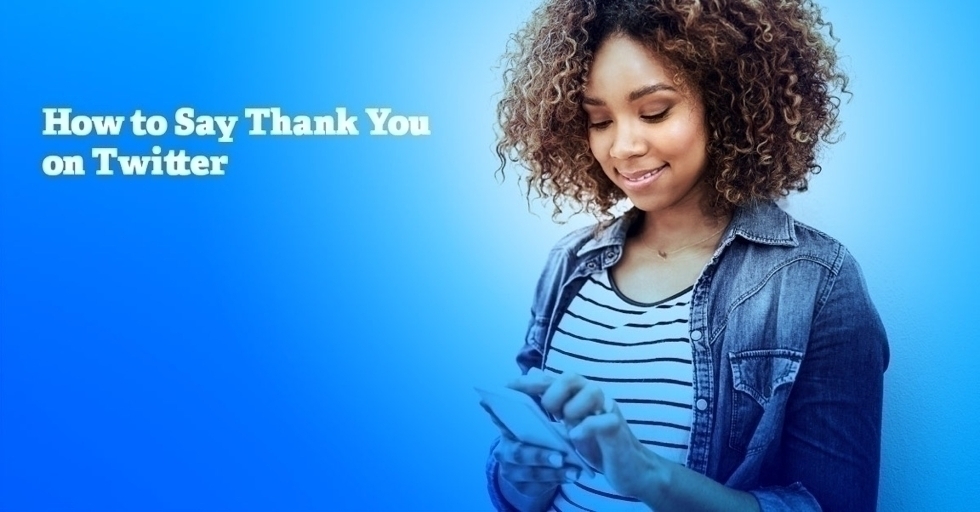
The post has been updated based on changes to Twitter's protocols (9.21.2017).
“Thank you.”
Those are two, very simple words. But when it comes to using them on social media, do you know how to thank people who mention you on Twitter?
As it turns out, the manners you learned as a small child are the same ones you want to use on social media. Thanking someone really comes down to genuinely acknowledging them. This is true whether they’ve shared your content, given you a shout out or included you in a post on their own site.
Our Up-To-Date Twitter Thank You Guide
How to Say Thank You When Someone @Mentions You
Twitter users will mention you for a variety of reasons. It could be to give you credit for one of your blog posts. It might be to highlight an event to which your business is related. It may be that they visited your business and are mentioning you to signal they were there. Or it could be to call your attention to something they’re sharing they feel is relevant.
When someone mentions you, acknowledge them! They are directly engaging with you. Make sure to read the tweet carefully. If push comes to shove, a simple “thank you” will do. But, the more personal your response, the better.
When someone mentions you on Twitter, acknowledge them!Click to Tweet
Personal responses can start a dialogue and keep fans engaged.
Do: Thank and/or acknowledge mentions.
Do: Include a personal sentiment.
Do: Answer a question if it’s posed.
Do: Include a link in your reply, if it’s relevant.
Don’t: Simply ignore mentions.
NOTE:
An @mention is any time a Twitter user shares a username preceded by an @ symbol without a space separating them. This creates a hyperlink to your profile.
How to Say Thank You for a Retweet
When someone retweets your content, they are showing interest in your work. Thanking them acknowledges you saw the retweet. It also encourages them to retweet you again.
Do: Thank someone who retweets.
Do: Make the thank you as personal as possible, including a question if you can.
Don’t: Automate the thank you. Ever.
BONUS – If a user retweets your tweet with a manual retweet or a auto retweet with comment, make sure to favorite the retweet. See the 3 Types of Retweets Below.
How to Thank Someone Who Shares Content From Your Site
This one is a little trickier. Because if a Twitter user doesn’t @mention you, you won’t always be alerted that your content was shared.
But, if you find that someone did share your content, make sure to thank them. Like saying thank you for a retweet, this acknowledges you noticed their share. And, it encourages them to say thank you again.
Thank those who share your content. It encourages them to do so again.Click to Tweet
Do: Thank someone who shares your content.
Do: Read the tweet they published and engage with it.
How to Say Thank You For Someone Mentioning You on Their Website or Blog
Being mentioned by another author, in an article or on a blog post, is like digital gold. It gives you validity as an expert in your field. It broadens your reach as a brand. And if there’s a link back to your site, it strengthens your website’s organic SEO.
Make sure to thank the person who mentioned you. Share their article. @mention them.
If the author published their piece through an online publication, @mention the publication too. If other industry experts are mentioned in the article, consider also giving a shout out to them on Twitter. In some instances, this might require more than one tweet. That’s totally fine.
The idea is to give others as much recognition as possible.
Do: Share the article or blog post in which you are mentioned.
Do: Acknowledge the person who mentioned you, @mentioning them if possible.
Do: @mention all twitter accounts connected to the blog post or article possible.
Don’t: Try and take credit for the article as though it were your own.
Did someone mention you in their blog post or article? Acknowledge the person who mentioned you, @mentioning them if possible.Click to Tweet
How to Say Thank You For a Follow
Tweeting without followers is like singing without an audience. It might make you happy, but no one will appreciate your hard work. When a fan follows you, that’s the best time to break the ice, start a longer conversation, and keep them engaged.
But, not all new followers are valuable. Don’t waste you time thanking a spammer or a robot. And, don’t appear to be a robot yourself by using an automated system.
Do: Evaluate new followers to determine if they’re actual people.
Do: Thank real followers personally.
Don’t: Thank followers who are spammers or robots.
Don’t: Thank followers using an automated system.
How to Say Thank You for an Event
Did you get invited to or sign yourself up for an event? Sending out a thank you tweet that @mentions the event is a great way to connect with fellow Twitter users and industry leaders.
Thank those who host an event with their handle and event hashtag.Click to Tweet
Do: Say thank you for a great event.
Do: Use the event hashtag, if there is one.
Do: @mention anyone you met at or saw at the event, if you know their Twitter handle.
Don’t: Say anything snarky or that could be perceived as negative about the event or the attendees.
How to Say Thank You to Clients & Customers
Happy clients and customers are a business’ best referral source. If you have a long-term client or customer you value who is active on Twitter, recognize them. Not only will this make them feel good, if they too are in business, it will help promote their business.
Do: Give customers and clients a shout out with an @mention.
Don’t: Share any personal details about the individual you’re mentioning without their permission.
Offering congrats for a big achievement can help you build stronger client relationships.Click to Tweet
BONUS – Take your recognition to the next level by pairing the tweet with a blog post highlight. This could include:
- Offering congrats for a big achievement, such as reaching a milestone or launching a new product.
- Q&A with the client or customer.
- Business profile highlight what they do.
How to Respond to Negative Tweets

How to Reply to a Negative Mention
As hard as you may try, you’re not going to please everyone. At some point, someone will say something negative about your business. And, Twitter may be the place they do so.
Does this mean you shouldn’t be on Twitter? No. Absolutely not. Someone can say something negative about your business on Twitter, whether you participate on the platform or not. The upside of being on Twitter, is you have the ability to respond.
As with any conflict resolution, try to move the conversation out of the public eye as quickly as possible. Furthermore, if the issue is resolved in a positive manner, feel out the Twitter user. If you think they’d be amiable to doing so, ask if they’d consider deleting their previous negative tweet or at least following it up with something about how the issue was resolved.
Move negative conversations out of the public eye as quickly as possible.Click to Tweet
Do: Reply to the negative Tweet.
Do: Invite the Tweeter user to contact you by phone or email.
Don’t: Say anything negative about the Twitter user.
Don’t: Engage in a heated back and forth on Twitter.
When to Not Reply to a Negative Mention
Yes. We just got done telling you to reply to negative tweets and invite the user to contact you outside of a public forum. But, there are some instances when you’ll want to refrain from engaging a Twitter users. These include:
When Excessive Profanity is Used – If a Twitter user is using excessive profanity, report the tweet.
When Threats are Made – This is another instance when you should report the tweet.
When You’ve Requested the User Contacts You Offline, but They’ve Continued to Tweet Negative Sentiments – Continuing to respond at this point just ads fuel to the fire. Additionally, your continued engagement ads validity to the user.

3 Types of Retweets
Users can retweet content in three different ways.
1. Manual Retweet (Copy & Paste)
The copy and paste method is old school. It harkens back to the early days of Twitter, before you could share fancy things like images, Twitter cards, and video.
As the name would suggest, a user literally copies and pastes your tweet as their own. Proper decorum is to also include the original tweeter’s name and either “RT” (retweet) or “MT” (modified tweet).
2. Auto Retweet
In 2009, Twitter began rolling out a new “retweet” feature. This allows users to retweet your content directly from the tweet itself – no copy and paste needed!
3. Auto Retweet with Comment
Standard retweets within Twitter had one significant drawback, they didn’t allow you to add any additional thoughts or sentiments. In 2016, Twitter changed this. Quote Retweets allow you to share a fellow Twitter user’s content and add up 140 additional characters of your own thoughts.
It’s important to note though, when you share a quote retweet, only a partial view of the tweet you’re retweeting will be displayed.
NOTE: If you use a scheduling service to plan your tweets, it could be that the copy and paste method is the only one available to you. Our favorite tweet scheduler is Buffer, which allows you to schedule all three types of retweets.
Keep Reading About Twitter Etiquette
9 Engaging Tweets to Spark Your Creativity
Are you feeling like your tweets are getting stagnant? These tips will help you spark your creativity.
The Truth About Twitter Etiquette
Twitter etiquette helps protects you and your business from any potential hiccups. Get the inside scoop on proper Twitter decorum.
How to Respond to Follows, Replies and Retweets on Twitter
It’s not always easy to know how to respond to each type of interaction. We’ve outlined how to respond to follows, replies, and retweets.




